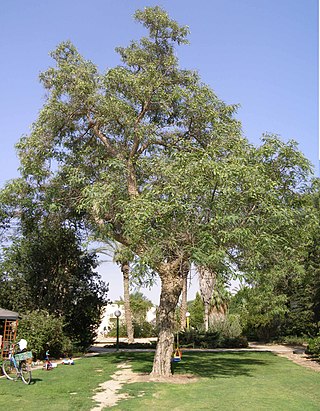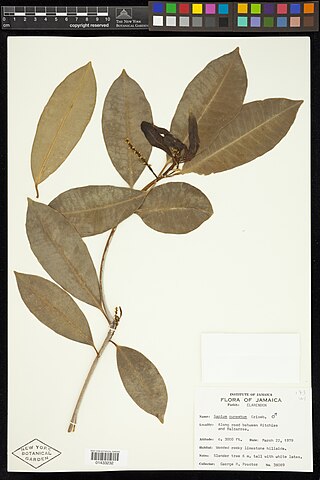
Robinia is a genus of flowering plants in the family Fabaceae, tribe Robinieae, native to North America. Commonly known as locusts, they are deciduous trees and shrubs growing 4–25 metres (13–82 ft) tall. The leaves are pinnate with 7–21 oval leaflets. The flowers are white or pink, in usually pendulous racemes. Many species have thorny shoots, and several have sticky hairs on the shoots.

The subfamily Detarioideae is one of the subdivisions of the plant family Fabaceae (legumes). This subfamily includes many tropical trees, some of which are used for timber or have ecological importance. The subfamily consists of 84 genera, most of which are native to Africa and Asia. Pride of Burma and tamarind are two of the most notable species in Detarioideae. It has the following clade-based definition:
The most inclusive crown clade containing Goniorrhachis marginataTaub. and Aphanocalyx cynometroidesOliv., but not Cercis canadensisL., Duparquetia orchidaceaBaill., or Bobgunnia fistuloides(Harms) J. H. Kirkbr. & Wiersema.

Tipuana tipu, also known as tipa, rosewood and pride of Bolivia, is a South American tree.

Lennea is a genus of legume in the family Fabaceae. It contains three species native to central and southern Mexico and Central America.
Gentianella crassulifolia is a species of flowering plant in the family Gentianaceae.
Macrocarpaea thamnoides is a species of plant in the family Gentianaceae. It is endemic to Jamaica. It is threatened by habitat loss.
Reynosia is a genus of plant in family Rhamnaceae. Darlingplum is a common name for this genus.

Sapium cuneatum is a species of flowering plant in the family Euphorbiaceae. It is endemic to Jamaica.

Gliricidia is a genus of flowering plants in the legume family, Fabaceae and tribe Robinieae. Its native range is Mexico to Peru, but Gliricidia sepium has been widely introduced to other tropical zones.

Adesmia is a genus of flowering plants in the legume family, Fabaceae. It was recently assigned to the informal monophyletic Adesmia clade within the Dalbergieae.
Cascaronia astragalina is a species of flowering plant in the legume family, Fabaceae. It is the only member of the genus Cascaronia. It is a spindly shrub or multi-stemmed tree native to southern Bolivia and northwestern Argentina. It grows in seasonally-dry subtropical forests, at forest margins and along rivers.
Herpyza is a genus of flowering plants in the legume family, Fabaceae. It contains a single species, Herpyza grandiflora, an herbaceous perennial endemic to Cuba. It belongs to the subfamily Faboideae.
Pictetia is a genus of about eight species of trees and shrubs in the family Fabaceae with spiny stems and spine-tipped leaflets. The genus is endemic to the Greater Antilles, but its closest relatives are in Mesoamerica and Africa.

Poitea is a genus of flowering plants in the legume family, Fabaceae. It includes 12 species of trees and shrubs native to the Caribbean islands of Cuba, Hispaniola, Puerto Rico, the Virgin Islands, and Dominica. Typical habitats include seasonally-dry tropical lowland to montane forest, thicket, and thorn scrub, often in secondary vegetation and on steep slopes or roadsides. It belongs to the subfamily Faboideae.
Guzmania mucronata is a species of flowering plant in the family Bromeliaceae. This species is endemic to Northern Venezuela.
Calliandra cruegeri is a species of flowering plants of the genus Calliandra in the family Fabaceae.
Poissonia is a genus of flowering plants in the legume family, Fabaceae. It includes five species of trees, shrubs, and herbs native to Peru, Bolivia, and northwestern Argentina. Typical habitats include seasonally-dry tropical and subtropical forest and shrubland, generally along river and stream banks, and open vegetation in arid areas. It belongs to the subfamily Faboideae, tribe Robinieae.
Poitea carinalis is a species of flowering plant in the family Fabaceae. It is a small deciduous tree or dry shrub and when in flower, usually February–April, an individual Poitea (Sabinea) can be seen from a mile away as the entire tree turns brilliant red, the flowers have the typical pea form with a long keel. Scattered individuals occur throughout the dry shrub and are occasionally planted elsewhere and since it has been adopted as the national flower of Dominica, people are now encouraged to plant it more widely. The flowers appear just before the new leaves unfurl and attract an abundance of insects, hummingbirds and bananaquits, but last for only a short time. Out of flower, it has 6-8 pairs of leaflets and a flattened pod. It is endemic to Dominica.
Meso-Papilionoideae is a monophyletic clade of the flowering plant subfamily Faboideae that includes the majority of papilionoid legumes. This clade is consistently resolved in molecular phylogenies. It contains many agronomically important genera, including Arachis (peanut), Cicer (chickpea), Glycine (soybean), Medicago (alfalfa), Phaseolus, Trifolium (clover), Vicia (vetch), and Vigna.

Hoppea fastigiata is a species of herbaceous plant in the family Gentianaceae. It is a small branched herb with oppositely arranged ovate, subsessile leaves. White flowers appear in terminal or axillary cymes. Flowering and fruiting season is September-October.







